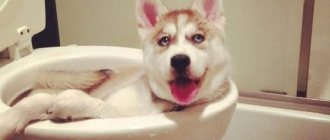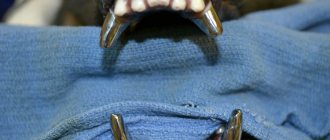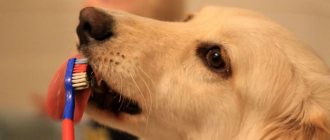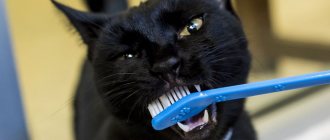All dog owners need to know when puppies lose their baby teeth. Despite the naturalness, this process does not always proceed easily and unnoticed. Some complications require veterinarian intervention, so don't overlook alarming behavioral changes on your baby's part.
When do puppies start teething?
When introducing complementary foods, it is very important to note whether dogs have baby teeth. Until this moment, the pet is simply not able to chew solid food, so it is completely dependent on its mother.
The first snow-white teeth appear 20-25 days after birth and are fully grown by 1.5-2 months. The exact timing of eruption depends on the breed. In miniature dogs, this process is slightly delayed, occurring at 5-6 weeks of life.
Baby teeth
Puppies that have just been born have no teeth at all and feed exclusively on their mother's milk. After 20–30 days from birth, their first baby teeth begin to appear.
The exception is decorative and dwarf dog breeds, in which the first teeth erupt at the age of 1.5 months. With proper development of the jaw, the number of primary teeth should be 28 (equally at the top and bottom): 4 canines, 12 incisors and 12 molars (premolars). The canines cut first, then the incisors, and then the premolars.
A little about the bite
After the milk teeth fall out, the four-legged pet grows 42 molars. Their position affects abrasion and wearability. With proper bite, a healthy dentition is preserved almost until old age.
Types of bites
The closure of the upper and lower jaws varies slightly between breeds. In such cases, the deviation from the norm is explained by genetics and is not a pathology.
There are 4 types of bite:
- Scissor-shaped
. The anatomical norm is when the upper incisors neatly cover the lower ones. When closing, the jaws do not touch, and a small gap of 3 mm is formed between them.
- Snack
. The lower jaw extends beyond the upper jaw, exposing the teeth located on it. This variety is typical for pugs, bulldogs and boxers.
- Pincer-shaped
. The jaws close in a straight line, so the incisors quickly wear down and become unusable.
- Underbite
. The gap formed during closure exceeds 3 mm. This violation is typical for a too shortened lower or elongated upper jaw. Due to the tight compression, the fangs wear down and break.
The last type is the most dangerous. Unlike a pincer bite, when overbiting, not only the incisors are erased, but the entire dentition.
Correct bite formula
With a correct bite, the animal should have exactly 42 teeth: 22 on the lower jaw and 20 on the upper. These include:
- 12 incisors;
- 4 fangs;
- 16 premolars;
- 10 molars.
Most breeds have a scissor bite. Misaligned jaws or a tongue protruding from a closed mouth is considered a pathology.
How many months do dogs change their teeth?
In most cases, the dissolution of milky roots occurs at the end of the 3rd or beginning of the 4th month. The entire “combat kit” appears by the first year of life. The exact time depends on the breed of the pet and some external factors.
Breed characteristics
Despite the general norm for the molar row, the number of teeth in the milk row of large and dwarf breeds differs from each other. The former grow only 28, while the latter grow 32. The remaining differences can be found in the example table.
| Breed | Age of complete change of dentition | Pain during teething | Possibility of complications |
| Large (Labrador, German Shepherd) | Up to 9 months | Low | Low |
| Dwarf (Spitz, Yorkshire Terrier) | Up to 11 months | High | High |
Knowing at what age dogs' teeth change, you can avoid possible complications. If the deviation from the norm is more than 2 weeks, be sure to contact your veterinarian.
External factors
In addition to breed characteristics, other factors are also important. The time at which a dog's teeth change depends on the climate, the quality of food and water consumed, and health status. Delayed appearance and frequent complications are typical for animals from cold regions that receive exclusively soft food and tap water that has not been pre-treated.
How teeth change
The order in which permanent teeth appear is different from the order in which baby teeth grow. The canines are not the first to be renewed, the incisors come before them, then all the others, then the canines are the last. There are more molars than baby teeth. By the age of one year, a healthy animal has 20 pieces at the top and 22 at the bottom.
When teeth begin to change, any owner notices this by changes in the pet’s behavior. If this does not happen, some decide to loosen the dog’s teeth themselves to speed up the renewal process. This cannot be done; the minimum harm to the pet from this is a severe painful shock. If renewal has not begun by the age of six months, you need to contact a veterinarian.
Symptoms
Symptoms of renewal manifest themselves in different ways. Their intensity is influenced by the individual pain threshold of the animal, the quality of nutrition, and the dog’s general health.
Typically, when baby teeth change, the following changes in behavior occur:
- severe itching in the gums forces the pet to chew on everything it comes across;
- eating problems, loss of appetite;
- lethargy, loss of strength, decreased activity;
- increased body temperature;
- diarrhea caused by licking everything around.
Many owners say that when a puppy's teeth change, he begins to bite. This is especially dangerous if there are small children in the house, who, out of habit, climb up to the pet to play with it. It is important to provide him with peace and his own territory in the house. It is recommended to take care in advance of the availability of special toys that the dog is allowed to chew.
Complications
The difficult period of formation of the adult jaw is complicated by several factors:
- Having an incorrect bite. It occurs due to deviations in the growth process of molars and owner intervention when old ones fall out.
- Diseases associated with gum inflammation. Renewal is always accompanied by it; minor inflammation, causing itching, is present throughout the entire period of changing teeth. But if it remains after the roots have grown or has an acute form, it brings severe pain to the animal.
- Delay. If baby teeth are still present at the age of 6-7 months, this is a deviation. As a result, malocclusion occurs when they fall out late, injury to the gums, cheeks, and other complications.
Experts advise owners of representatives of any breed to contact a veterinarian if the teeth do not change after 4-5 months.
The order and features of changing teeth in puppies
Teeth change in dogs occurs in a certain sequence. It is quite difficult not to notice this process, since it is accompanied by certain behavioral and physiological signs.
Sequence: from incisors to molars
A series of molars, canines, premolars and molars grow just inside the gums, putting pressure on the deciduous roots. Gradually they become thinner and fall out of the sockets, making way for permanent teeth. They appear in the following sequence:
- incisors – 3-4 months;
- fangs – 4-6 months;
- premolars – 6-7 months;
- molars – 5-8 months.
Molars erupt in several stages. The very first ones fix the dentition, contributing to the formation of a correct bite.
Behavioral and physiological signs of baby tooth loss
If the process is accompanied by pain, the pet may refuse to eat. Swollen gums return to normal within a couple of days after eruption. Your appetite should return on the second day. If this does not happen, it is better to take the baby to the veterinarian.
In the first days, the pet will constantly ask to be held or hide under a blanket. This is absolutely normal, since due to the changes occurring, his body temperature rises slightly (within 0.5 ° C).
You should only worry if the deviation from the norm persists for more than 2 days, and the puppy himself shows causeless aggression. These symptoms may indicate injury to the intestinal walls as a result of swallowing a lost tooth.
One of the most obvious signs is itching. The baby will chew everything he sees, and also scratch his face on the furniture or with his paws.
If any of the above symptoms appear, carefully look into your pet’s mouth. Slightly swollen and reddened gums, increased salivation and an unpleasant odor that persists for 1 month will help you recognize a new stage of growing up.
A little bleeding is acceptable immediately after prolapse. It stops on its own within 3 minutes.
Milk teeth - features of change in different breeds
The formation and process of teething can be divided into several stages:
- Age 3 weeks. Beginning of teething (12 incisors in total);
- 8 weeks – young puppies should have 12 incisors, 12 premolars and 4 canines in their mouth;
- 4 months – change of primary incisors to permanent ones. Usually the lower ones fall out first, and then the upper ones;
- 5 months. At this age, the dog's incisors should be all molars;
- 6 months – change of fangs;
- After 7 months, the replacement of premolars begins;
- By 10 months of age, a young dog should have 42 permanent molars (4 canines, 10 molars, 16 premolars and 12 incisors).
The owner of his four-legged friend needs to monitor these stages. The growth of baby teeth, their replacement and correct bite are the main points that affect the dog’s health. You also need to take into account that not all breeds change according to the above established schedule. For example, the change of teeth in dwarf dogs is different.
- Yorkshire Terrier. Perhaps one of the most problematic breeds. These little friends have to have their baby teeth removed because they do not fall out on time and can interfere with the formation of a correct bite. Very often, veterinarians observe double rows of teeth in Yorkies. Therefore, to prevent various diseases of the gums and teeth, the owners of this breed need to show their pet to the doctor once every six months.
- Pug. Another problem breed in this area. When changing baby teeth, curvature of the incisors and malocclusion are often observed. Only a veterinarian can help correct the situation;
- Dachshund. Hunting dog breed. There are no special problems when cutting teeth and changing them. Some deviations from the schedule are possible, but no more than 1-2 weeks. The owners can rest assured about their pet.
- Spitz. Each subspecies of this breed has its own individual characteristics. But the smaller the dog, the more teething problems may arise. The most common bites are straight, undershot and overshot. The breed standard is a scissor bite.
Helping a puppy through a difficult period
When dogs change teeth, their immunity decreases. For the entire period, it is recommended to protect your pet from stress, intense physical activity, contact with other animals and vaccinations. You should also review your current diet, strengthen oral hygiene measures, and purchase teethers.
Gnawing accessories
A teether is a special device filled with water. Keep it in the refrigerator before use, as the low temperature reduces itching and inflammation. Using a teether, a regular rubber toy, or chewable treats can prevent damage to furniture and valuables.
Please note that it is better to remove dangerous objects away during this period. A baby suffering from itching may accidentally bite the wire and get an electric shock.
Oral hygiene
Regular oral hygiene protects against stomatitis, caries, tartar and other dental diseases. Your baby needs to be taught to brush his teeth to avoid problems in the future.
To clean the enamel, you need to purchase a special toothbrush, veterinary paste or cleaning gel. Move strictly from top to bottom from the outside of the jaw towards the inside.
The procedure should be repeated 5-10 times a month, and every 2 months the pet should be examined at a veterinary clinic. This way you can easily understand whether your dog has baby teeth, or whether the process of replacing them with molars has already come to an end.
Feeding
To form a beautiful and healthy bite, your puppy will need a lot of calcium and phosphorus. When feeding natural foods, be sure to include in your diet:
- veal;
- raw carrots;
- sea fish and fish oil;
- fermented milk products (cottage cheese, cheeses, kefir);
- beef liver;
- spongy bones and boiled cartilage;
- sea buckthorn oil.
The addition of ready-made vitamin and mineral complexes should be discussed with your veterinarian. Otherwise, you risk causing an overabundance of vitamins.
If your pet eats dry food, then it already contains all the necessary elements. All you have to do is focus on the baby’s well-being, combining granules and wet canned food. The former will help relieve itching, and the latter will help reduce the sensitivity of inflamed gums.
Nutrition when changing teeth
In order for your pet to have strong, healthy teeth, and also to avoid any problems during the period of appearance and growth of both milk and permanent teeth, you need to provide the animal with a rational, balanced diet. The food must contain calcium , fluorine, phosphorus and other minerals, which are found in large quantities in cottage cheese, kefir, cheese, and vegetables.
You can give your puppy fish oil, sea buckthorn oil and brewer's yeast. He will also need to enrich his diet by taking complex mineral and vitamin supplements. All this will contribute to the trouble-free change and growth of your pet’s healthy teeth, as well as the formation of a proper skeleton.
Possible complications
Dwarf breeds have the hardest time with the change of baby teeth. If your pet is at risk, examine its oral cavity every day so as not to miss warning signs of complications.
Gum inflammation
Accompanied by redness and swelling of the mucous membranes, as well as profuse salivation, which worsens the appearance of the fur on the chest. This complication usually goes away on its own, but sometimes develops into periodontal disease. It can be identified by severe bleeding of the gums and a strong odor from the mouth.
Stuck teeth
Some animals retain 2 rows of teeth at once. This complication is called persistence. It is fraught with increased trauma to the mucous membranes and cheeks, as well as malocclusion.
Be sure to check if your dog has baby teeth next to his molars. If you find two shoots in one hole, contact your veterinarian. Sometimes the problem can be solved by manual loosening, but in most cases surgery cannot be avoided.
Malocclusion
Improper closing of the jaws is typical for breeds with an elongated muzzle: dachshunds, labradors, dobermans, rottweilers. It is facilitated by games of tug of war, feeding exclusively soft food and persistence.
To correct the bite, rubber corrector rings are used that act as braces. If the animal is not a show animal, then it is enough to prevent the situation from worsening and control the position of the jaws.
Malfunctions of the gastrointestinal tract
Quite often, babies experience diarrhea. It is not dangerous, as the stool quickly returns to normal. You should only worry if you experience symptoms of dehydration:
- dry mucous membranes, nose and coat;
- loss of activity and increasing lethargy;
- slow smoothing of skin crumpled into a fold by fingers.
Additionally, vomiting and fever may occur. A pet with such symptoms must be shown to a veterinarian within the first day after their discovery. Otherwise, he may die.
When do you need veterinary help?
You should seek help if you have alarming symptoms or if your puppy’s teeth change is 7-14 days behind the norm. Particularly dangerous are prolonged bleeding, putrid odor from the mouth and loss of consciousness. In all these situations, you will have to visit the veterinary clinic outside the planned schedule, since self-medication will not help here.
Conclusion
Remember that the change of teeth in puppies is not a disease, but a completely natural process. With your support, your four-legged pet will easily overcome this stage of growing up, so just follow the basic recommendations and do not ignore warning signs.
The article is of a recommendatory nature. Contact your veterinarian!
The puppy is teething and he bites! What to do?
Puppies' mouths are filled with 28 tiny, razor-sharp teeth that seem to enjoy nipping at your fingers and toes. Although this is annoying behavior, it is completely normal when puppies are teething.
When does a puppy lose teeth?
Puppies get their baby teeth at a much earlier age than human babies—as early as two weeks. As puppies grow, they explore their world with their mouths. When a puppy is about 3-4 months old, the puppy teeth begin to fall out to make room for the 42 adult teeth. (That's about 10 more teeth than humans.) This process can be terribly painful for your puppy—his gums will hurt. When teething, you may notice your puppy drooling or see small spots of blood on his toys, although if you notice anything unusual, talk to your vet, as both symptoms could also be related to a more serious problem. Once your puppy is 6 months old, his baby teeth should fall out. You may find puppy teeth on the floor, although the puppy will likely swallow most of the teeth. If you find that some of them are not falling out, be sure to notify your veterinarian. He may have to remove them.
How to survive teething in a puppy?
The teething process is very uncomfortable for the puppy. Your job as a responsible owner is to provide your puppy with something he can chew to soothe sore gums and help make the process more comfortable. Otherwise, the puppy may chew your shoes, your sofa, or your children's toys. The best toys for teething puppies depend on size and activity level. It can be:
- Rubber teething toys (that you can put in the freezer).
- Edible rings for puppy teething.
- Scented puppy chew toys.
Ask your veterinarian what the safest chew toys are for your puppy, and whatever you choose, always supervise chewing and playtime because nothing is safe for every dog. Check toys periodically to make sure they are not falling apart. Your puppy should not chew the kibble or pull out bits of fiber or filling.
How to stop a puppy from biting?
Puppies naturally bite each other when playing and sometimes don't realize how hard they can bite without hurting the other dog. If they bite too hard, the other dog squeals loudly, warning the puppy, “Hey, that hurts!” You can teach your puppy that a bite hurts by shouting loud, high-pitched " ouch " if he bites you. Then give him a treat or verbal praise for backing off. But it may also be that some puppies will become even more excited if you scream. In this case, calmly turn around or walk away to calm down. After you have taught him that biting you hurts, let him know what exactly he can bite or chew. If he starts nibbling on your fingers or toes while you're playing, offer him a toy instead. Keep toys where you can easily reach them so you can quickly offer an acceptable alternative when your puppy feels the need to chew. If he continues to bite you, stop the play session so he understands that biting is not rewarded. You may also need to redirect your puppy's excess energy into a walk or exercise session. Never hit or otherwise physically punish your dog. If you think your pet is biting out of aggression (not during play), talk to your veterinarian or dog trainer about how to deal with this behavior. Caring for your puppy's adult teeth
Once your dog has grown all of his adult teeth and you want to keep them pearly whites. Begin the brushing routine by getting your puppy used to having his mouth and teeth in contact with a toothbrush at an early age. You can purchase a dog toothbrush and toothpaste (an enzymatic product is recommended as it works both mechanically and chemically to remove plaque). Do not use human toothpaste because it may make your dog sick if he ingests it. Also keep in mind that even if they are no longer teething, adult dogs still love to chew. So keep giving your dog chew toys and edible treats that will satisfy this natural instinct and help keep his teeth clean. Good luck with your new puppy and enjoy this little miracle. Soon the memories of your puppy as a biting, chewing little monster will be remembered with a smile and love.











